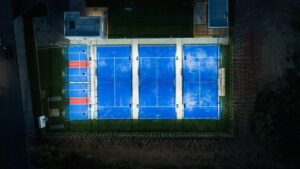The Court Layout: A Detailed Look at Padel Basics
3 min read
The Court Layout: A Detailed Look at Padel Basics
As a padel enthusiast, you’ve probably already fallen in love with the sport. With its fast-paced, exciting gameplay and a mix of tennis and squash elements, padel has quickly gained popularity all around the world. But before you step onto the court, it’s important to understand the basics of the game. In this article, we’ll take a detailed look at the court layout, providing you with the foundation you need to become a skilled padel player.
An Overview of the Court
The first thing you’ll notice when you set foot on a padel court is its distinctive shape. Padel courts are enclosed spaces with glass walls, creating a unique playing environment. The glass walls allow for exciting rallies as the ball can rebound off the walls, adding a whole new dimension to the game. The court is rectangular, measuring 20 meters in length and 10 meters in width. It is divided into two halves by a net, much like a tennis court.
The Service Boxes and Scoring System
On each half of the court, there are two service boxes, one on the left and one on the right, just like in tennis. The server must stand in one of these boxes and hit the ball diagonally to their opponent’s service box. The serve must clear the net and bounce within the opposing player’s service box. If the ball fails to meet these requirements, it results in a fault.
Padel has a unique scoring system that can seem a little puzzling at first, but once you get the hang of it, it adds to the excitement of the game. The points are counted in a similar way to tennis, with zero being called “love.” The scoring sequence is as follows: love, 15, 30, and 40. However, unlike tennis, padel does not use “deuce” or “advantage” – instead, at 40-40, it’s a tiebreaker point, called “cuarenta iguales.”
The Baseline and The No-Volley Zone
The baseline is the line that runs parallel to the net at the back of the court. It is commonly referred to as the “back wall” and provides a clear boundary for both players. When serving, the ball must bounce in the opposing player’s service box before they can return it. As we mentioned earlier, the walls can come into play during a rally, adding a thrilling element to the game.
Another essential feature of the padel court is the “no-volley zone” or “kitchen.” This area is marked by two yellow lines and spans from the net to a distance of 3 meters back on each side. Players are not allowed to hit a volley (hitting the ball before it bounces) while standing in this zone. This rule prevents players from dominating the game at the net and adds an extra challenge to strategic play.
Understanding the Court Layout
To summarize, the padel court layout consists of service boxes on each half, divided by a net. The baseline and the no-volley zone provide clear boundaries for the players. The glass walls surrounding the court allow for exciting shots and rebounds off the walls. Understanding these key elements will help you navigate the court with confidence.
So, the next time you step onto a padel court, keep these basics in mind. Whether you’re a beginner or an experienced player, knowing the ins and outs of the court layout is crucial. Embrace the fast-paced, thrilling nature of the sport and explore the many strategies and tactics that will help you become a formidable padel player. Happy playing!






